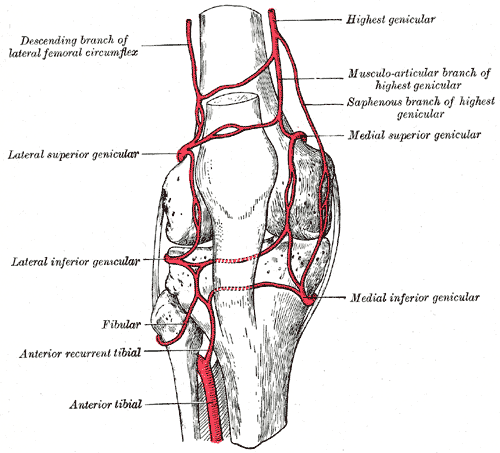Fibular artery
Editor-In-Chief: C. Michael Gibson, M.S., M.D. [1]
In anatomy, the fibular artery (also known as the peroneal artery) supplies blood to the lateral compartment of the leg and is typically a branch of posterior tibial artery.[1]
Structure
The fibular artery branches off the posterior tibial artery in the upper part of the leg proper, just below the knee. It runs downward in the deep posterior compartment of the leg, just medial to the fibula. It supplies a number of branches to both the lateral and anterior compartments of the leg; it also provides a nutrient artery to the fibula.
The fibular artery is accompanied by small veins (venae comitantes) known as fibular veins
Nomenclature
At one point in its history, both the Greek term perone and the Latin term fibula were competing to describe the smaller bone of the leg. Many of the arteries, veins, nerves, and muscles in the leg are named according to what bone they are near (e.g. tibialis anterior and the tibial nerve are near the tibia). So the artery that runs near the smaller leg bone had two names: the peroneal artery and the fibular artery. The term fibula eventually became the standard name for the bone, but many of the related arteries, muscles, and nerves are still called by the Greek derived name peroneal. The Terminologia Anatomica, the international standard for anatomical nomenclature, states that both fibula and perone derived names are acceptable, but lists the fibula derived names as the preferred terms.
Like fibula, the perone (pronounced pair-uh-knee) means pin of a brooch or buckle.
References
- ↑ Day C, Orme R (2006). "Popliteal artery branching patterns -- an angiographic study". Clin Radiol. 61 (8): 696–9. PMID 16843754.
Additional images
-
Circumpatellar anastomosis.
External links
- Template:Medcyclopaedia
- Distal peroneal artery - is it an effective outflow source? - Vascularweb.org
- Template:EMedicineDictionary
- Template:SUNYAnatomyLabs - "The Leg: Nerves and Vessels of the Deep Compartment of the Leg"
